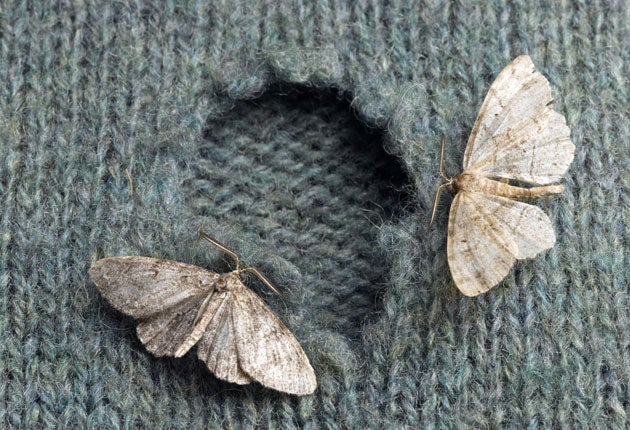The curse of the moth
They're back – and this time we haven't got the balls to stop them. Francesca Infante reports

One of Britain's grubbier little secrets is out of the closet. Clothes moths appear to be making an annoyingly widespread return – their numbers swollen by the insects' love for our bulging, and not always impeccably laundered, wardrobes.
Reports of infestations have risen sharply in the past six months. Some have attributed this to the demise of the traditional mothball, others to global warming. But, it seems, the real problem is us and our over-heated bedrooms full of more clothes than ever before, not all of which are as clean as they could be.
The larvae of the common clothes moth, or Tineola bisselliella, can live for up to two years among our clothes – and these days they have an awful lot more to lunch on. Consumer expert Lucy Siegle said research by Cambridge University indicates that the average British woman buys about 62lb (28kg) of clothes each year and has four times as many clothes in her wardrobe as she did in 1980.
An added inducement for the moths is our failure to wash our woollens and other natural fabrics regularly. Traces of sweat and the occasional food stain make the garment more delicious to hungry moth larvae.
Kate Hamer, UK technical manager for the pest control giant Rentokil, said our fondness for central heating has played its part, too. "The particularly snowy conditions we had during the winter made people much more likely to crank up their central heating, allowing the moths to live happily in their homes through the winter," she said. "Like all insects, moths are cold blooded, so warm temperatures act as a stimulant and effectively speed up their life cycles which can cause them to breed more quickly and prolifically."
Pest controllers such as Cliff Randall from London say that the number of moth-related call-outs he receives has more than doubled since December 2010. "Before Christmas I would usually do three to four a month, but in the past six months that has risen to more like three to four a week," he said. "Most clients are uncertain where the infestation is coming from, but we almost always find the source under a large piece of furniture that hasn't been moved in a while and has just been Hoovered around rather than under. It offers a perfect breeding ground, and then clients realise too late that a big chunk of their carpet is gone."
Retailers including John Lewis and Robert Dyas report a "massive growth" in moth treatment products. The traditional mothball was removed from sale in the UK after the active ingredient, naphthalene, was found to be highly toxic and banned by the EU in 2008. Since then, new products from cedarwood balls to pheromone adhesive strips have entered the market.
Robert Dyas, which stocks 12 different moth-specific repellents and insecticides, has seen a sales increase of 51 per cent across its range compared with figures from the same period in 2009, with no fewer than 386,556 individual moth products being sold in the first five months of 2011.
Join our commenting forum
Join thought-provoking conversations, follow other Independent readers and see their replies
Comments
Bookmark popover
Removed from bookmarks